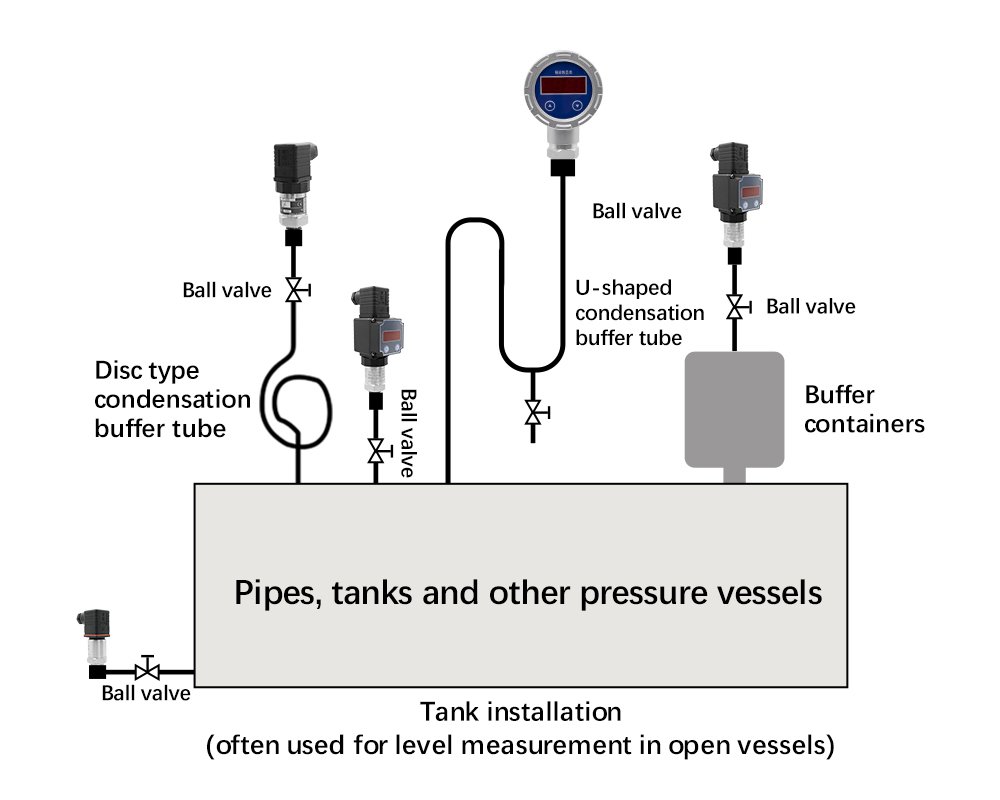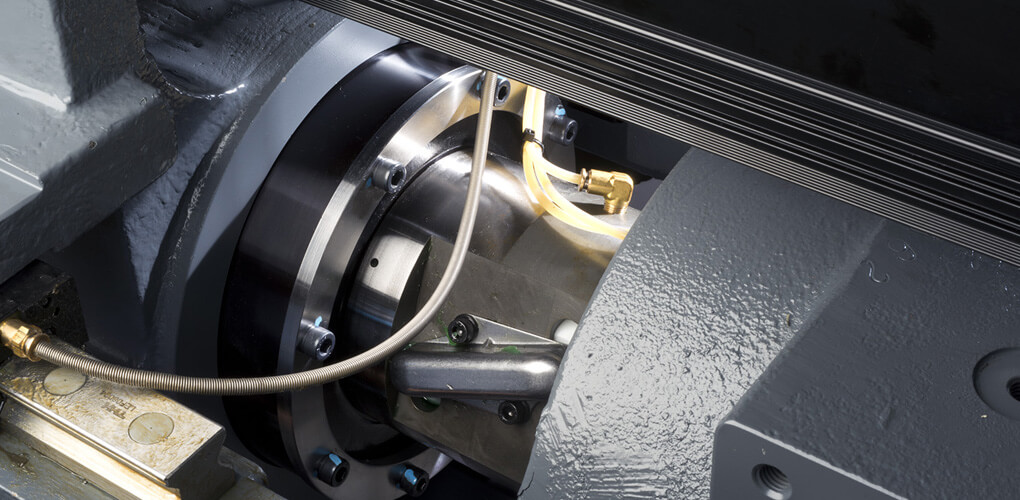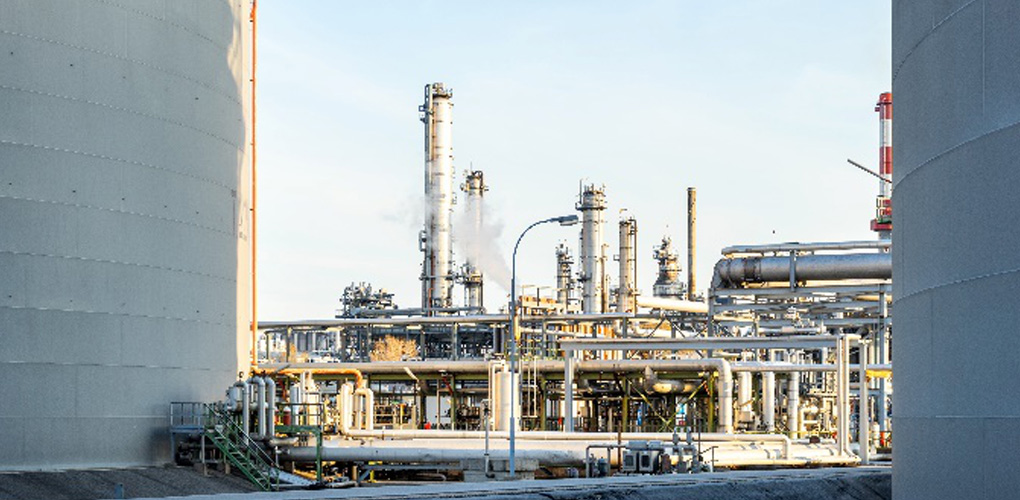Pressure sensor classification-how much do you know ?
1. Pressure sensor Definition:
Pressure sensor are sensors used to measure the pressure of liquids and gases. Similar to other sensors, pressure sensors convert pressure into electrical signal output when working.

2. Pressure sensors classification:
Pressure sensor vary greatly in technology, design, performance, working conditions and price. According to preliminary estimates, there are more than 60 technologies of pressure sensors and at least 300 companies producing pressure sensors in the world.
Pressure sensors can be classified by the pressure range they can measure, operating temperature, and pressure type; the most important of which is pressure type. According to the classification method of pressure type, pressure sensors can be divided into the following five categories:
① Absolute pressure sensors:
This pressure sensor measures the true pressure of a fluid, that is, relative to the pressure of a vacuum. The absolute atmospheric pressure at sea level is 101.325kPa (14.7?PSI).
② gauge pressure sensors
This kind of pressure sensor can measure the pressure relative to the atmospheric pressure at a specific position. The tire pressure gauge is an example. When the tire pressure gauge displays a reading of 0 PSI, it means that the pressure inside the tire is equal to the atmospheric pressure, which is 14.7 PSI.
③ Vacuum pressure sensors:
This kind of pressure sensor is used to measure pressure less than one atmosphere. Some vacuum pressure sensors in the industry read values relative to one atmosphere (the readings are negative), while others refer to their absolute pressure.
④ Differential pressure gauge:
This instrument is used to measure the pressure difference between two pressures, such as measuring the pressure difference between both ends of an oil filter. The differential pressure meter is also used to measure flow or the liquid level in a pressure vessel.
⑤. Sealed pressure sensors:
This instrument is similar to a gauge pressure sensor, but it is specially calibrated to measure pressure relative to sea level.
According to different structures and principles, they can be divided into: strain gauge, piezoresistive, capacitive, piezoelectric, vibration frequency pressure sensors, etc. In addition, there are photoelectric, fiber optic, and ultrasonic pressure sensors.
1. Strain pressure sensor
Strain pressure sensor is a sensor that indirectly measures pressure by measuring the strain of various elastic elements. According to the different materials used, strain elements can be divided into two categories: metal and semiconductor. The working principle of strain elements is based on the "strain effect" of conductors and semiconductors, that is, when conductors and semiconductor materials are mechanically deformed, their resistance values will change.
When a metal wire is acted upon by an external force, its length and cross-sectional area will change, and its resistance value will change. If a metal wire is elongated by an external force, its length will increase, but its cross-sectional area will decrease, and its resistance value will increase. big. When the metal wire is compressed by external force, the length decreases and the cross-section increases, and the resistance value decreases. As long as the change in voltage applied to both ends of the resistor is measured, the strain of the strained wire can be obtained.
2. Piezoresistive pressure sensor
Piezoresistive pressure sensor refers to a sensor made by utilizing the piezoresistive effect of single crystal silicon material and integrated circuit technology. After the single crystal silicon material is subjected to force, the resistivity changes, and the electrical signal output proportional to the force change can be obtained through the measurement circuit. It is also called a diffused silicon piezoresistive pressure sensor. It is different from the adhesive strain gauge which needs to indirectly sense the external force through the elastic sensitive element, but directly senses the measured pressure through the silicon diaphragm.
Piezoresistive pressure sensors are mainly based on the piezoresistive effect.
The piezoresistive effect is used to describe the change in resistance of a material under mechanical stress. Unlike the piezoelectric effect, the piezoresistive effect only produces impedance changes and does not generate charges.
Most metallic materials and semiconductor materials have been found to have a piezoresistive effect. Among them, the piezoresistive effect in semiconductor materials is much greater than that in metals. Since silicon is the main raw material for today's integrated circuits, the application of piezoresistive elements made of silicon becomes very meaningful. The resistance change of silicon comes not only from the stress-related geometric deformation, but also from the stress-related resistance of the material itself, which makes its degree factor hundreds of times greater than that of metals.
The resistance change of N-type silicon is mainly due to the redistribution of carriers between the conduction band valleys of different mobilities caused by the displacement of its three conduction band valley pairs, which in turn changes the mobility of electrons in different flow directions. The second is due to changes in the effective mass associated with changes in the conduction band valley shape. In P-type silicon, this phenomenon becomes more complex and also results in equivalent mass changes and hole conversion.
Piezoresistive pressure sensors are generally connected to the Wheatstone bridge through leads.
Normally, there is no external pressure on the sensitive core, and the bridge is in a balanced state (called zero position). When the sensor is under pressure, the chip resistance changes, and the bridge will lose balance. If a constant current or voltage power supply is added to the bridge, the bridge will output a voltage signal corresponding to the pressure, so that the resistance change of the sensor is converted into a pressure signal output through the bridge.
The bridge detects the change in resistance value, and after amplification, it is converted into a corresponding current signal through voltage and current conversion. The current signal is compensated by the nonlinear correction loop, which generates a linear corresponding relationship between the input voltage and the 4 ~20mA standard output signal.
In order to reduce the impact of temperature changes on the core resistance value and improve measurement accuracy, pressure sensors adopt temperature compensation measures to maintain high levels of technical indicators such as zero-point drift, sensitivity, linearity, and stability.
3. Capacitive pressure sensor
Capacitive pressure sensor is a pressure sensor that uses capacitance as a sensitive element to convert the measured pressure into a change in capacitance value. This kind of pressure sensor generally uses a circular metal film or a metal-plated film as an electrode of the capacitor. When the film deforms due to pressure, the capacitance formed between the film and the fixed electrode changes, and the output is proportional to the voltage through the measurement circuit. Electrical signals of a certain relationship. Capacitive pressure sensors are pole-change capacitive sensors and can be divided into single capacitive pressure sensors and differential capacitive pressure sensors.
The single capacitive pressure sensor is composed of a circular membrane and a fixed electrode. The membrane deforms under the action of pressure, thereby changing the capacity of the capacitor. Its sensitivity is roughly proportional to the area of the membrane and pressure and inversely proportional to the tension of the membrane and the distance from the membrane to the fixed electrode. Another type of fixed electrode is in the shape of a concave spherical surface, and the diaphragm is a tensioned plane fixed around the periphery. The diaphragm can be made of plastic with a metal layer.
This type is suitable for measuring low pressure and has higher overload capacity.
A single capacitive pressure sensor for measuring high pressure can also be made using a moving pole diaphragm with a piston. This type can reduce the direct pressure area of the diaphragm, so that a thinner diaphragm can be used to improve sensitivity. It is also integrally packaged with various compensation and protection parts and amplification circuits to improve anti-interference capabilities. This sensor is suitable for measuring dynamic high pressures and for telemetry of aircraft. Single capacitive pressure sensors also come in microphone type (i.e. microphone type) and stethoscope type.
The pressure diaphragm electrode of the differential capacitive pressure sensor is located between two fixed electrodes, forming two capacitors. Under the action of pressure, the capacity of one capacitor increases and the capacity of the other decreases accordingly, and the measurement result is output by a differential circuit. Its fixed electrode is made by plating a metal layer on the concave curved glass surface. The diaphragm is protected by the concave surface from rupture when overloaded. Differential capacitive pressure sensors have higher sensitivity and better linearity than single capacitive pressure sensors, but they are more difficult to process (especially difficult to ensure symmetry) and cannot isolate the gas or liquid being measured, so they are not suitable for working in areas with corrosion. properties or impurities in the fluid.
4. Piezoelectric pressure sensor
Piezoelectric pressure sensors are mainly based on the piezoelectric effect. They use electrical components and other machinery to convert the pressure to be measured into electricity, and then carry out related measurement precision instruments, such as many pressure transmitters and pressure sensors.
Piezoelectric sensors cannot be used in static measurements because the charge after being acted upon by an external force can only be preserved when the loop has infinite input impedance. But that's not actually the case. Therefore, piezoelectric sensors can only be used in dynamic measurements. Its main piezoelectric materials are: ammonium dihydrogen phosphate, potassium sodium tartrate and quartz. The piezoelectric effect was discovered on quartz.
When the stress changes, the change in the electric field is very small, and other piezoelectric crystals will replace the quartz. Potassium sodium tartrate has a large piezoelectric coefficient and piezoelectric sensitivity. However, it can only be used indoors where the humidity and temperature are relatively low. Ammonium dihydrogen phosphate is an artificial crystal that can be used in high humidity and high temperature environments, so its application is very wide. With the development of technology, the piezoelectric effect has also been applied to polycrystals. For example: piezoelectric ceramics, magnesium niobate piezoelectric ceramics, niobate piezoelectric ceramics, barium titanate piezoelectric ceramics, etc. are included.
The piezoelectric effect can be divided into: positive piezoelectric effect and inverse piezoelectric effect.
The positive piezoelectric effect refers to: when the crystal is acted upon by an external force in a fixed direction, an electric polarization phenomenon occurs internally, and charges with opposite signs are generated on two surfaces at the same time; when the external force is removed, the crystal returns to its uncharged state. state; when the direction of the external force changes, the polarity of the charge also changes; the amount of charge generated by the force on the crystal is proportional to the size of the external force. Piezoelectric sensors are mostly made using the positive piezoelectric effect.
The inverse piezoelectric effect refers to the phenomenon of mechanical deformation of the crystal caused by applying an alternating electric field to the crystal, also known as the electrostrictive effect. Transmitters made with the inverse piezoelectric effect can be used in electroacoustic and ultrasonic engineering.
There are five basic forms of force deformation of piezoelectric sensitive elements: thickness deformation type, length deformation type, volume deformation type, thickness shear type, and plane shear type. Piezoelectric crystals are anisotropic, and not all crystals can produce piezoelectric effects in these five states. For example, quartz crystal has no volume deformation piezoelectric effect, but has good thickness deformation and length deformation piezoelectric effects.
5. Inductive pressure sensor
Electromagnetic pressure sensor is a general term for a variety of sensors that utilize electromagnetic principles, including inductive pressure sensors, Hall pressure sensors, eddy current pressure sensors, etc.
The working principle of the inductive pressure sensor is that due to the difference in magnetic materials and magnetic permeability, when the pressure acts on the diaphragm, the size of the air gap changes. The change in the air gap affects the change in the coil inductance. The processing circuit can convert this change in inductance. into corresponding signal output, thereby achieving the purpose of measuring pressure.
This type of pressure sensors can be divided into two types according to the changes in the magnetic circuit: variable reluctance and variable permeability.
The advantages of inductive pressure sensors are high sensitivity and large measurement range; the disadvantage is that they cannot be used in high-frequency dynamic environments.The main components of the variable reluctance pressure sensor are the iron core and the diaphragm. They form a magnetic circuit with the air gap between them. When there is pressure, the size of the air gap changes, that is, the magnetic resistance changes. If a certain voltage is applied to the iron core coil, the current will change with the change of the air gap, and the pressure will be measured.
In situations where the magnetic flux density is high, the magnetic permeability of ferromagnetic materials is unstable. In this case, a variable permeability pressure sensor can be used for measurement. The variable permeability pressure sensor uses a movable magnetic element instead of the iron core. Changes in pressure cause the magnetic element to move, thereby changing the magnetic permeability, and thus the pressure value is obtained.
6. Hall pressure sensors
Hall pressure sensors are based on the Hall effect of certain semiconductor materials. The Hall effect refers to the phenomenon that when a solid conductor is placed in a magnetic field and a current flows through it, the charge carriers in the conductor are deflected to one side by the Lorentz force, thereby generating a voltage (Hall voltage). The electric field force caused by the voltage balances the Lorentz force. Through the polarity of the Hall voltage, it can be confirmed that the current inside the conductor is caused by the movement of negatively charged particles (free electrons).
Applying a magnetic field perpendicular to the direction of the current to the conductor will cause the electrons in the conductor to be gathered by the Lorentz force, thus generating an electric field in the direction of the electron gathering. This electric field will cause the subsequent electrons to be balanced by the electric force. The Lorentz force caused by the magnetic field allows subsequent electrons to pass smoothly without deflecting. This is called the Hall effect. The built-in voltage generated is called Hall voltage.
When the magnetic field is an alternating magnetic field, the Hall electromotive force is also an alternating electromotive force of the same frequency.
The time to establish the Hall electromotive force is very short, so its response frequency is high. The material of an ideal Hall element requires high resistivity and carrier mobility in order to obtain a large Hall electromotive force. Most of the materials commonly used for Hall elements are semiconductors, including N-type silicon (Si), indium antimonide (InSb), indium arsenide (InAs), germanium (Ge), gallium arsenide (GaAs) and multi-layer semiconductor structural materials, N The Hall coefficient, temperature stability and linearity of type silicon are good, and the temperature drift of gallium arsenide is small, so it is currently used.
7. Eddy current pressure sensor
Pressure sensor based on eddy current effect. The eddy current effect is caused by a moving magnetic field intersecting a metal conductor, or by a moving metal conductor intersecting a magnetic field perpendicularly. In short, it is caused by the electromagnetic induction effect. This action creates an electric current that circulates within the conductor.
The characteristics of eddy current make eddy current detection have characteristics such as zero frequency response, so the eddy current pressure sensor can be used for the detection of static force.
8. Vibrating wire pressure sensor
The vibrating wire pressure sensor is a frequency sensitive sensor. This frequency measurement is extremely accurate because both time and frequency are physical parameters that can be measured accurately. The resistance, inductance, and cable resistance in the frequency signal transmission process can be ignored. The influence of factors such as capacitance. At the same time, the vibrating wire pressure sensor also has the advantages of strong anti-interference ability, small zero-point drift, good temperature characteristics, simple structure, high resolution, stable performance, convenient data transmission, processing and storage, and easy instrumentation. Digitalization, so vibrating wire pressure sensors can also be one of the development directions of sensing technology.
The sensitive element of the vibrating wire pressure sensors is a tightened steel string.
The natural frequency of the sensitive element is related to the magnitude of the tightening force. The length of the string is fixed, and the change in the vibration frequency of the string can be used to measure the magnitude of the pulling force, that is, the input is a force signal and the output is a frequency signal. The vibrating wire pressure sensor is divided into upper and lower parts. The lower component is mainly a sensitive element assembly. The upper component is an aluminum shell, which contains an electronic module and a wiring terminal. It is divided into two small chambers so that the sealing of the electronic module chamber will not be affected when wiring.
Vibrating wire pressure sensors can choose between current output type and frequency output type. When the vibrating wire pressure sensor is in operation, the vibrating wire continuously vibrates at its resonant frequency. When the measured pressure changes, the frequency will change. This frequency signal can be converted into a 4~20mA current signal through a converter.












